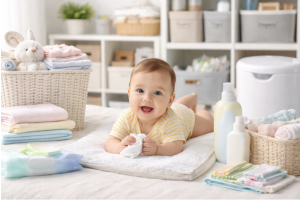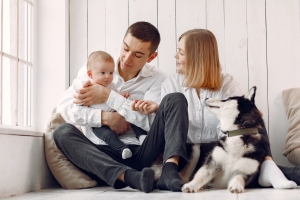How to Create a Safe and Harmonious Environment for Pets and Babies

Expecting a baby is both exciting and terrifying. To enjoy the event as much as possible, preparation is key. In addition to stocking up on diapers and snagging a future spot in a daycare, you need to be sure your pets are ready for the new family member.
But she's a sweetheart!
Sure, your pets are sweet and wonderful, and wouldn't harm a fly. Unfortunately, many pets are frightened by babies, others think babies must be some kind of squeaky toy, and some dogs think babies are wounded prey animals and want to kill and eat them. However, with the proper introduction and set-up, your pets and baby can learn to co-exist peacefully.
Keep firmly in mind that toddlers can be very upsetting to pets. Even the most even-tempered pet may get cross when a toddler keeps grabbing its tail or falls on top of the pet. Pets and toddlers should never interact unless under strict adult supervision. Pets and babies should never interact, period.
Harmony begins with separation
You will need to keep the pet physically separated from the baby for many years to come. Strategically located pet gates are part of a harmonious pet and child home. You'll need to keep the pet out of the child's areas, and the child out of the pet's areas.
Prepare the home long before the baby arrives. Set up the baby gates and get the dog accustomed to staying out of the baby's sleeping, caring, and playing areas. You don't want the dog's entire world to be turned upside down on the day the new baby comes home.

Train the dog
After you have set up your baby gates, consider doll practice. Buy a doll that resembles a newborn and pretend it's a baby. Hold it in your lap, carry it around, and place it in the bassinet. While you do this, reward the dog for remaining calm and out of the way. A dog who knows to relax and lie down during baby time is a pleasure to own.
Many dog trainers offer classes to help expectant parents prepare their dog for the new baby. These classes can help you train your dog to heel next to a stroller, calmly ignore a screaming baby, and not react to baby swings and noisy baby toys.
Take it slow
It may take two to three months for your pet to fully accept and get used to the presence of a new baby. Let the pet sniff things that smell like the baby and get used to the new sounds and routine associated with the baby. Let the dog watch you care for the baby while safely confined behind a baby gate.
As the baby matures into a toddler, you can allow the pet and toddler to occupy the same room while closely supervised. You already taught your dog how to behave around children; now, you need to teach the child how to behave around dogs and cats. The child needs to learn not to grab, hit, climb on, or chase pets.
Don't neglect the pet
New parents will be busy with the baby. However, you need to make sure your pets get their needs met as well. The dog will still need to be walked daily, and both dogs and cats will need playtime and cuddle time with their owners. A contented pet whose needs are being met is less likely to act out and get frustrated and angry with the new baby.
Before the baby arrives, make sure your pets are properly insured. The costs of a birth can be quite steep and you don't want to have to deal with any unexpected veterinarian bills. You might also want to hire a dog walker who can exercise the dog during late pregnancy and for several months after the birth, or locate a doggy daycare that the dog can attend before and after the birth. Thus, the dog's needs are taken care of and the dog does not experience an abrupt disruption of its routine linked to the baby's arrival.
It is also wise to get a veterinarian to examine your pet before the baby arrives. Make sure the pet is dewormed and vaccinated and does not have any untreated conditions. A pet that is miserable from an ear infection is more likely to lash out.
Never leave them alone together
Do not ever leave a child under the age of six alone with a pet, not even for a minute. If the adult leaves, either the child or the pet must go with the adult. This is a basic safety precaution everyone should heed. Millions of young children are bitten by dogs every year. Most of the dogs responsible for these bites are the family's beloved pet, responding defensively to something the child did. Conversely, cats and small dogs can be accidentally injured by a boisterous young child.
These heart-breaking situations are so easy to avoid. If you prepare your home and pet before the birth and carefully train, separate, and supervise, your entire family, furry and otherwise, can enjoy life together.






